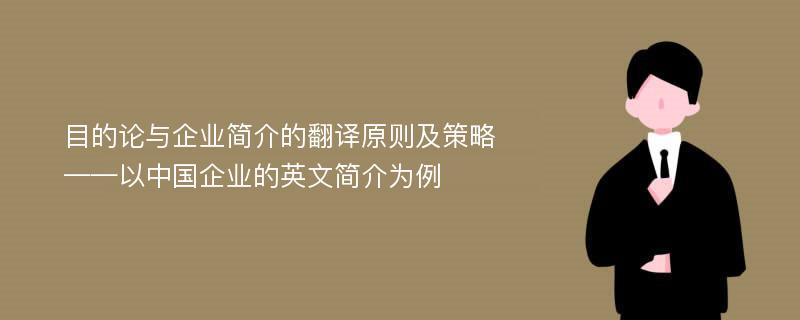
论文摘要
随着世界经济全球化的进程不断深入,中国与世界各国的经济交往越来越密切。中国公司企业有更多的机会进入国际市场,参与国际竞争。良好的公司简介有助于其树立良好的企业形象,提高产品的知名度,帮助企业顺利进入国际市场。公司简介作为一种特殊文本,其最终目的是为本公司树立良好的企业形象,推销企业产品,扩大其服务范围,从而提高企业的竞争力。公司简介翻译的最终目的也是如此。由于公司简介翻译目的的特殊性,传统的翻译理论无法满足公司简介翻译的需要,因为首先英语和汉语分属两个截然不同的语言体系,在翻译过程中很难实现完全的对等;其次,公司简介是一种有目的的宣传文体,如果在翻译广告时盲目追求形式对等,就会妨碍其交际功能的实现;再次,文化背景的巨大差异也是实现翻译对等的一大障碍。作为对传统翻译理论的一个重大突破,德国功能派翻译理论为公司简介翻译的理论研究开辟了一个新视角。该理论以目的论为中心,强调翻译是一种有目的的行为。翻译的目的决定翻译过程,即目的决定方法。翻译方法和翻译策略必须由译文预期的目的或功能来决定。目的论中的“目的性原则”是其首要原则,另外还有连贯法则和忠实法则,而连贯法则和忠实法则都要服从于目的法则。这些观点为某些不符合传统翻译标准的翻译方法提供了有力的理论支持,尤其适用于公司简介这种有明确目的应用文体的翻译。公司简介翻译不仅是语言的翻译,而且还包含着文化上的转换。由于中西方语言和文化上存在着巨大的差异,在公司简介文本上也有各自的特色。在中国公司简介的英译过程中,译者必须考虑到英语国家公司简介的语言和文化特色,以及英语国家消费者的文化习惯和审美意识。公司简介的功能决定了公司简介翻译的目的。本研究以目的论为理论框架,阐述了公司简介的功能和目的,并参照英文平行文本探讨了英汉公司简介的语言和文化特征,指出了中国公司简介的英译要符合英语国家公司简介的语言和文化特色,这样才能满足英语国家消费者的需要。根据公司简介独特的功能及目的,指出广告翻译应该是一种以目的语为导向的创造性的翻译活动,在实现预期目的的过程中,译者不可避免地会对原文做文化和语言上的调整以适应目的语文化与目的语读者。本研究在对当前公司简介翻译存在的主要问题进行调查分析的基础上,提出了以目的语为导向的翻译的三原则,即准确性、可理解性和可接受性。同时,通过译例分析,建议中国公司简介的英译为了成功实现其预期功能应采取三种可行的翻译方法策略:增译、删译和重组。最后,本研究得出结论:功能翻译“目的论”对公司简介翻译的实践有很强的指导意义。译者应牢记目标文本的目的功能并能翻译出目标语读者能理解接受的文本。
论文目录
相关论文文献
- [1].Overcoming Cerebral Palsy to Be a Professional Translator[J]. China Today 2020(02)
- [2].Translator's Subjectivity in the Choice of the Original Text——A Case Study of Lin Yutang's Six Chapters of a Floating Life[J]. 校园英语 2016(31)
- [3].Taking an Inclusive Approach[J]. ChinAfrica 2016(12)
- [4].The Cross-cultural communication of Confucianism introduced by Lin Yu-tang[J]. 山西青年 2017(02)
- [5].Translating China for Western Readers in the Context of Globalization(PartⅡ)[J]. 翻译论坛 2016(04)
- [6].A Contrastive Study on the Two Chinese versions of Washington Ivring's Rural Life in England[J]. 校园英语 2017(04)
- [7].HEART TO HEART[J]. Beijing Review 2017(21)
- [8].Spotlight on Southwest China's Small Towns[J]. China Today 2017(03)
- [9].Translator's Subjectivity and Translator's Training in the Context of Globalization[J]. 校园英语 2017(12)
- [10].Human Translator and Translation Technology[J]. 校园英语 2017(16)
- [11].Heart To Heart[J]. ChinAfrica 2017(06)
- [12].Analysis on Yan Fu and the Ideological Features in His Time[J]. 校园英语 2017(29)
- [13].A Critical Review on Douglas Robinson's Becoming a Translator: an Introduction to the Theory and Practice of Translation[J]. 校园英语 2017(28)
- [14].拓宽领域深化交流 探索翻译教育的创新发展——国际译联第七届亚洲翻译家论坛综述[J]. 东方翻译 2013(06)
- [15].Shaping a New Economy[J]. ChinAfrica 2020(05)
- [16].Are Today's Women Fully Empowered?[J]. ChinAfrica 2020(11)
- [17].On Becoming a Translator[J]. 校园英语 2015(21)
- [18].Deconstructive Reconsideration of Translation[J]. 校园英语 2014(26)
- [19].翻译者地位的改变(英文)[J]. 科技致富向导 2011(20)
- [20].Functions and Benefits of SDL Translator's Workbench 2007[J]. 海外英语 2012(15)
- [21].Wmatrix-based Study of Translator's Style——A Case Analysis of Two English Versions of The True Story of Ah Q[J]. 海外英语 2017(16)
- [22].Cultural Transmission of language in Translation[J]. 校园英语 2020(20)
- [23].Commentary on My Translation of You Can You Will from Jauss' Perspective of Reception Aesthetics[J]. 海外英语 2017(08)
- [24].Following Fate[J]. Beijing Review 2008(29)
- [25].A Brief Analysis of the Translator's Subjectivity in the Process of Computer Aided Translation[J]. 海外英语 2019(23)
- [26].On Savory's Principles of Translation[J]. 海外英语 2016(03)
- [27].Self-Retranslation as Intralingual Translation:Two Special Cases in the English Translations of San Guo Yan Yi[J]. Language and Semiotic Studies 2017(02)
- [28].A Comparative Analysis of the English Versions of Prelude to Water Melody in Light of Eco-Translatology[J]. 海外英语 2020(03)
- [29].A Study on the Strategies and Influencing Factors of the Subtitle Translation of the Film Mulan from the Perspective of the Rewriting Theory[J]. 海外英语 2019(03)
- [30].On the Requirements and Strategies for Translators in Chinese-English Translation of Tourist Materials[J]. 海外英语 2017(02)
